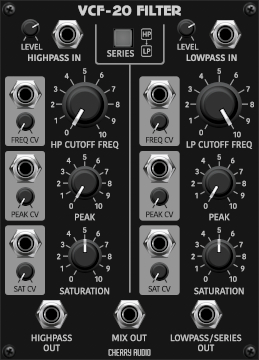The Cherry Audio VCF-20 Filter is an analog-style, voltage-controllable, dual highpass/lowpass filter that recreates the aggressive tones of a classic 70s Japanese monosynth. Its uniquely raunchy sound totally transforms the overall tonality of Voltage Modular! The two resonant filters can be used individually, in series, or manually patched in various configurations and are both capable of screaming self-oscillation. We carefully A/B'd the VCF-20 Filter with the coveted "version 35" filter of the original instrument and we think you'll be delighted with its authenticity.
Inputs, Outputs and Controls
Highpass/Lowpass In jacks and Level control- These are the input jacks for the highpass and lowpass filters. Signals input here can be attenuated before being sent to the filter via their respective Level knobs. Be sure to try using these to “dial in” the filter. Changing the input level of a signal can drastically change the way the filter sounds especially when using high peak settings.
Series- Engaging this button internally routes the output of the highpass filter to the input of the lowpass filter. This is a quick way to use both filters in series with only one input patched. Note though that this bypasses the input stage level control of the lowpass filter. It is possible however to manually patch the filter in series and use both input stages.
HP Cutoff Freq- Sets the cutoff frequency of the 6 dB/oct highpass filter. All frequencies higher than this will be allowed to pass through the filter while frequencies lower than the cutoff will be attenuated at a rate of 6 dB per/octave.
LP Cutoff Freq- Sets the cutoff frequency of the 12 dB/oct lowpass filter. All frequencies lower than this will be allowed to pass through the filter while frequencies higher than the cutoff will be attenuated at a rate of 12 dB per/octave.
HP Freq CV and LP Freq CV inputs and attenuators- CV mod inputs and attenuators for externally controlling each filter’s cutoff frequency.
Peak (resonance)- Emphasizes sound energy at and around the cutoff frequency by adding feedback from the filter’s output back to its input. As the peak is increased, any modulations or knob twisting of the cutoff frequency becomes more pronounced and can create the classic “vowel-sound” this filter is known for. When turned up past seven or so, the filter begins to feed back enough to self-oscillate. (Note that unlike the original, a cable must be patched to the filter’s input to hear it self-oscillate. This is designed to save CPU when the filter is not in use.)
Peak CV inputs and attenuators- CV mod inputs and attenuators for externally controlling the peak (resonance) of each filter. This is a feature the original monosynth did not have. The resonance of this filter can get out of hand pretty quickly, so it’s quite nice to have a little extra control via the CV inputs.
Saturation- Adds distortion to the signal. Used subtly it can add extra harmonics to a smooth bass sound or some tasteful grit to a vocal sample. Higher settings will produce the aggressive character that the original is famous for. Be careful though... when used in conjunction with a high peak setting, this filter will literally scream!
About MS-style Oscillator Distortion: You may notice that VCF-20 doesn't necessarily distort in the expected way when using the standard green Voltage Modular Oscillator (especially with square waves). This is because the wacky, characteristic MS-style filter distortion is partially the result of the not-exactly-correct-on-an-oscilloscope waveforms output from the original MS synth oscillators. These "incorrect" waveshapes are accurately recreated in the VCO-20 Dual Oscillator module, so try it in conjunction with VCF-20.
Saturation CV inputs and attenuators- CV mod inputs and attenuators for externally controlling the saturation of each filter.
Highpass Out jack- Outputs the processed signal from the highpass filter.
Mix Out jack- Outputs the sum of both filters.
Lowpass/Series Out jack- Outputs the processed signal from the lowpass filter. When the Series button is engaged, this will output the signal sent to the highpass filter’s input which is then sent to the lowpass filter.
